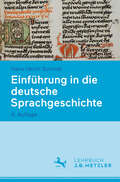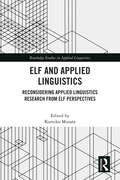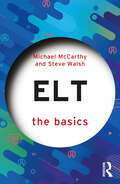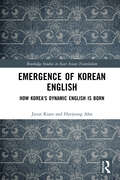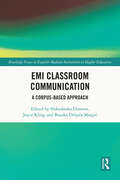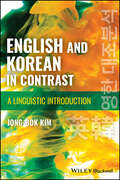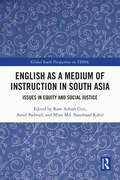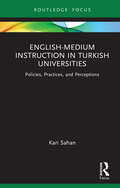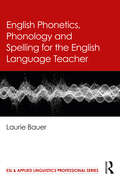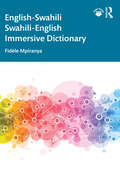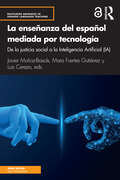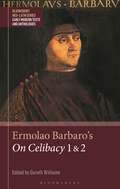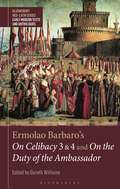- Table View
- List View
Einführung in die deutsche Sprachgeschichte
by Hans Ulrich SchmidDiese Einführung bietet einen Überblick über die Entwicklung der deutschen Sprache vom Althochdeutschen bis zum Frühneuhochdeutschen mit Ausblicken auf die jüngere Sprachgeschichte und die Gegenwartssprache. Soweit es für das Verständnis heutiger oder historischer Sprachformen notwendig ist, wird auch das Germanische und Indogermanische einbezogen. Der Autor stellt die Sprachentwicklung auf den verschiedenen Ebenen dar: Laut und Schrift, Bildung von Wörtern und Wortformen, Wortschatz, Syntax und Semantik (Bedeutungswandel). Mit Tabellen (zu Laut- und Flexionsparadigmen) und Überblicksdarstellungen, Abbildungen, Textbeispielen und Analysen sowie vertiefenden Literaturhinweisen. – Für die vierte Auflage wurde der Band komplett durchgesehen und aktualisiert.
ELF and Applied Linguistics: Reconsidering Applied Linguistics Research from ELF Perspectives (Routledge Studies in Applied Linguistics)
by Kumiko MurataWith help from a global cast of scholars, Kumiko Murata explores the remodelling of the discipline of applied linguistics, which traditionally regarded Anglophone native-speaker English as the standard for English as a lingua franca (ELF).This edited volume probes the dichotomy between the current focus of applied linguistic research and a drastically changed English use in a globalised world. This division is approached from diverse perspectives and with the overarching understanding of ELF as an indispensable area of applied linguistics research. The volume includes theoretical backgrounds to English as a lingua franca, the nature of ELF interactions, language policy and practice from an ELF perspective, and the relationship between multilingualism and ELF.A resourceful book not only to ELF researchers but also applied linguists in general, as well as policy makers, administrators, practicing teachers, and university students from diverse linguacultural backgrounds.
ELF and Applied Linguistics: Reconsidering Applied Linguistics Research from ELF Perspectives (Routledge Studies in Applied Linguistics)
by Kumiko MurataWith help from a global cast of scholars, Kumiko Murata explores the remodelling of the discipline of applied linguistics, which traditionally regarded Anglophone native-speaker English as the standard for English as a lingua franca (ELF).This edited volume probes the dichotomy between the current focus of applied linguistic research and a drastically changed English use in a globalised world. This division is approached from diverse perspectives and with the overarching understanding of ELF as an indispensable area of applied linguistics research. The volume includes theoretical backgrounds to English as a lingua franca, the nature of ELF interactions, language policy and practice from an ELF perspective, and the relationship between multilingualism and ELF.A resourceful book not only to ELF researchers but also applied linguists in general, as well as policy makers, administrators, practicing teachers, and university students from diverse linguacultural backgrounds.
ELT: The Basics (The Basics)
by Michael McCarthy Steve WalshELT: The Basics offers a clear, non-jargonistic introduction to English language teaching for EFL/ESL teachers in training, early career teachers, those considering taking up ELT, and experienced teachers who may want to read about the way the profession has developed and continues to evolve. Key features of this book include: Real classroom data and data from ELT training programmes Discussion of a wide range of learning contexts and different types of learners (young learners, adults, third age, academic, refugees and immigrants, etc.) Comparisons of different types of syllabuses and methods, and discussion of current technologies An emphasis on classroom interaction as the key to maximising learning Featuring a glossary of key terms, cartoons and illustrations, further reading, personal reflection points, and discussion of the most important and relevant research, this book is a clear and accessible introduction to the complex field of ELT.
ELT: The Basics (The Basics)
by Michael McCarthy Steve WalshELT: The Basics offers a clear, non-jargonistic introduction to English language teaching for EFL/ESL teachers in training, early career teachers, those considering taking up ELT, and experienced teachers who may want to read about the way the profession has developed and continues to evolve. Key features of this book include: Real classroom data and data from ELT training programmes Discussion of a wide range of learning contexts and different types of learners (young learners, adults, third age, academic, refugees and immigrants, etc.) Comparisons of different types of syllabuses and methods, and discussion of current technologies An emphasis on classroom interaction as the key to maximising learning Featuring a glossary of key terms, cartoons and illustrations, further reading, personal reflection points, and discussion of the most important and relevant research, this book is a clear and accessible introduction to the complex field of ELT.
Emergence of Korean English: How Korea's Dynamic English is Born (Routledge Studies in East Asian Translation)
by Jieun Kiaer Hyejeong AhnEmergence of Korean English explores the dynamic nature of emerging Korean English and its impact on Korean society, culture, and identity. This book challenges the negative stereotypes and stigmatization of Konglish and argues that it has been a great asset for Korea’s fast economic development. The fate of Korean English has been transformed in the time of the Korean wave as the K-fandom actively engages with Korean English. The book offers a comprehensive overview of Korea’s encounter with the English language and provides an in-depth analysis of linguistic characteristics, pragmatic features, and cross-cultural and cross-linguistic aspects of Korean English. The authors examine the unique linguistic features of Korean English, including phonological, syntactic, and lexical features, and highlight the sociocultural implications of these features for Korean society. In addition, the book discusses the role of Hallyu fandom languages in the emergence of Korean English and the growth of Korean pop culture worldwide. It also provides insights into the English fever in South Korea and its impact on education, society, and culture. This book is a valuable resource for scholars, students, and professionals who are interested in the emergence of Korean English and its social, cultural, and linguistic implications for Korea and the global community.
Emergence of Korean English: How Korea's Dynamic English is Born (Routledge Studies in East Asian Translation)
by Jieun Kiaer Hyejeong AhnEmergence of Korean English explores the dynamic nature of emerging Korean English and its impact on Korean society, culture, and identity. This book challenges the negative stereotypes and stigmatization of Konglish and argues that it has been a great asset for Korea’s fast economic development. The fate of Korean English has been transformed in the time of the Korean wave as the K-fandom actively engages with Korean English. The book offers a comprehensive overview of Korea’s encounter with the English language and provides an in-depth analysis of linguistic characteristics, pragmatic features, and cross-cultural and cross-linguistic aspects of Korean English. The authors examine the unique linguistic features of Korean English, including phonological, syntactic, and lexical features, and highlight the sociocultural implications of these features for Korean society. In addition, the book discusses the role of Hallyu fandom languages in the emergence of Korean English and the growth of Korean pop culture worldwide. It also provides insights into the English fever in South Korea and its impact on education, society, and culture. This book is a valuable resource for scholars, students, and professionals who are interested in the emergence of Korean English and its social, cultural, and linguistic implications for Korea and the global community.
EMI Classroom Communication: A Corpus-Based Approach (Routledge Focus on English-Medium Instruction in Higher Education)
by Slobodanka Dimova Joyce Kling Branka Drlja 269 A Margi 263Examining English medium instruction (EMI) through a corpus-based approach, this volume offers a critical inquiry into the use of different linguistic and pedagogical strategies in the EMI classroom. It explores aspects of content lecturers’ language use, pedagogy, and intercultural communicative competence by drawing on the findings obtained from EMI lecture corpus analysis and post-observation interviews with EMI lecturers from five universities in Croatia, Denmark, Italy, the Netherlands, and Spain. The book also offers insights into lecturers’ engagement with students in English, which is their second language, as well as their perception of differences between EMI and first-language-medium instruction (L1MI). Finally, the volume provides readers with corpus-based analysis of teachers’ oral ability profiles, as a basis for the identification of communicational challenges and provision of language support. The book will be of interest to scholars interested in EMI in higher education, and postgraduate students in applied linguistics and TESOL programs. It will also be relevant to teachers who are involved in EMI provision, teacher trainers who design support programs for EMI teachers, and policymakers who establish language-in-education policies for EMI.
EMI Classroom Communication: A Corpus-Based Approach (Routledge Focus on English-Medium Instruction in Higher Education)
by Slobodanka Dimova Joyce Kling Branka Drljača MargićExamining English medium instruction (EMI) through a corpus-based approach, this volume offers a critical inquiry into the use of different linguistic and pedagogical strategies in the EMI classroom. It explores aspects of content lecturers’ language use, pedagogy, and intercultural communicative competence by drawing on the findings obtained from EMI lecture corpus analysis and post-observation interviews with EMI lecturers from five universities in Croatia, Denmark, Italy, the Netherlands, and Spain. The book also offers insights into lecturers’ engagement with students in English, which is their second language, as well as their perception of differences between EMI and first-language-medium instruction (L1MI). Finally, the volume provides readers with corpus-based analysis of teachers’ oral ability profiles, as a basis for the identification of communicational challenges and provision of language support. The book will be of interest to scholars interested in EMI in higher education, and postgraduate students in applied linguistics and TESOL programs. It will also be relevant to teachers who are involved in EMI provision, teacher trainers who design support programs for EMI teachers, and policymakers who establish language-in-education policies for EMI.
English and Korean in Contrast: A Linguistic Introduction
by Jong-Bok KimENGLISH AND KOREAN IN CONTRAST English and Korean in Contrast: A Linguistic Introduction is the first book of its kind to present a comprehensive yet student-friendly comparative review of the grammars of English and Korean. Author Jong-Bok Kim, an internationally-recognized expert, offers rigorous contrastive analyses of all major aspects of English and Korean while addressing common usage errors made by learners of each language. Designed for both English- and Korean-language classrooms, this unique textbook describes and contrasts the two languages at every level from sound, word, and grammar to figurative language and metaphors. Throughout the text, the author uses an accessible, descriptive-based approach that covers both core and peripheral phenomena of English and Korean. Offering invaluable insights into the major sources of difficulty or ease in learning the two languages, English and Korean in Contrast: A Linguistic Introduction is the perfect undergraduate resource not only for English-speaking students studying Korean language and linguistics, but also for Korean-speaking students studying English language and linguistics.
English and Korean in Contrast: A Linguistic Introduction
by Jong-Bok KimENGLISH AND KOREAN IN CONTRAST English and Korean in Contrast: A Linguistic Introduction is the first book of its kind to present a comprehensive yet student-friendly comparative review of the grammars of English and Korean. Author Jong-Bok Kim, an internationally-recognized expert, offers rigorous contrastive analyses of all major aspects of English and Korean while addressing common usage errors made by learners of each language. Designed for both English- and Korean-language classrooms, this unique textbook describes and contrasts the two languages at every level from sound, word, and grammar to figurative language and metaphors. Throughout the text, the author uses an accessible, descriptive-based approach that covers both core and peripheral phenomena of English and Korean. Offering invaluable insights into the major sources of difficulty or ease in learning the two languages, English and Korean in Contrast: A Linguistic Introduction is the perfect undergraduate resource not only for English-speaking students studying Korean language and linguistics, but also for Korean-speaking students studying English language and linguistics.
English as a Medium of Instruction in South Asia: Issues in Equity and Social Justice (Global South Perspectives on TESOL)
by Ram Ashish Giri Amol Padwad Kabir, Mian Md. NaushaadThis book examines the ‘English mania phenomenon’ and the complex circumstances of adopting English Medium Instruction (EMI) by South Asian education systems and the effect of an uneven distribution of resources on the already under-resourced countries in the region. Chapters explore linguistic, social, and economic injustices by using an analytic-critical approach to examinations of the place, role, provisions, and practices of EMI in specific English language teaching (ELT) contexts. The book consequently advocates for the wholescale reform of a system, which, the authors argue, is unjust. Ultimately, the book explores socio-cultural, poststructuralist, and English linguistic imperialism theories to contribute a South Asian perspective on the controversy surrounding EMI and examine its role within a wider global discourse on equity and social justice. Critically examining the spread of English in South Asia, this book will be of relevance to researchers, scholars, and postgraduate students in applied linguistics, language education, TESOL, and sociolinguistics.
English as a Medium of Instruction in South Asia: Issues in Equity and Social Justice (Global South Perspectives on TESOL)
This book examines the ‘English mania phenomenon’ and the complex circumstances of adopting English Medium Instruction (EMI) by South Asian education systems and the effect of an uneven distribution of resources on the already under-resourced countries in the region. Chapters explore linguistic, social, and economic injustices by using an analytic-critical approach to examinations of the place, role, provisions, and practices of EMI in specific English language teaching (ELT) contexts. The book consequently advocates for the wholescale reform of a system, which, the authors argue, is unjust. Ultimately, the book explores socio-cultural, poststructuralist, and English linguistic imperialism theories to contribute a South Asian perspective on the controversy surrounding EMI and examine its role within a wider global discourse on equity and social justice. Critically examining the spread of English in South Asia, this book will be of relevance to researchers, scholars, and postgraduate students in applied linguistics, language education, TESOL, and sociolinguistics.
English-Medium Instruction in Turkish Universities: Policies, Practices, and Perceptions (Routledge Focus on English-Medium Instruction in Higher Education)
by Kari SahanIn response to the growing use of English as an international language, the number of English-medium instruction (EMI) programs in higher education has increased. However, decisions to implement EMI programs are often made through top-down policymaking processes with little consideration for the educational issues surrounding language policy changes.This book examines the variation with which EMI is implemented at universities in Turkey through a multilevel empirical investigation of policies, practices, and perceptions. In addition to providing a sociohistorical overview of EMI in Turkey, the book draws on a dataset that includes policy documents, classroom observations, interviews with teachers, and focus group discussions with students. Despite national policies which envision a "one-language-at-a-time" model of EMI education, this book argues that EMI is neither English-only nor English-always in practice. By highlighting the variation with which EMI is implemented at and across Turkish universities, this study illustrates the need for more comprehensive EMI policies and processes aimed at integrating content and language learning in higher education.Implications are discussed with respect to policy planning, program development, and pedagogical support and will be relevant for researchers and postgraduate research students interested in EMI, particularly in the Turkish context.
English-Medium Instruction in Turkish Universities: Policies, Practices, and Perceptions (Routledge Focus on English-Medium Instruction in Higher Education)
by Kari SahanIn response to the growing use of English as an international language, the number of English-medium instruction (EMI) programs in higher education has increased. However, decisions to implement EMI programs are often made through top-down policymaking processes with little consideration for the educational issues surrounding language policy changes.This book examines the variation with which EMI is implemented at universities in Turkey through a multilevel empirical investigation of policies, practices, and perceptions. In addition to providing a sociohistorical overview of EMI in Turkey, the book draws on a dataset that includes policy documents, classroom observations, interviews with teachers, and focus group discussions with students. Despite national policies which envision a "one-language-at-a-time" model of EMI education, this book argues that EMI is neither English-only nor English-always in practice. By highlighting the variation with which EMI is implemented at and across Turkish universities, this study illustrates the need for more comprehensive EMI policies and processes aimed at integrating content and language learning in higher education.Implications are discussed with respect to policy planning, program development, and pedagogical support and will be relevant for researchers and postgraduate research students interested in EMI, particularly in the Turkish context.
English Phonetics and Pronunciation Practice
by Inger M. Mees Paul CarleyEnglish Phonetics and Pronunciation Practice provides a unique introduction to basic articulatory phonetics for students of English. Taking a practical approach, this book teaches the pronunciation of modern standard non-regional British English to intermediate and advanced learners worldwide.Now fully updated and restructured, the more concise new edition:• provides an up-to-date description of the pronunciation of modern British English;• demonstrates the use of English consonants and vowels in a variety of contexts and in contrast with other sounds with which they may be confused;• includes expanded theory sections for an improved balance of theory and practice;• is supported by extensive online audio material.Ideal for studying pronunciation in the classroom or for independent student practice, English Phonetics and Pronunciation Practice is essential reading for any student of pronunciation and phonetics.
English Phonetics and Pronunciation Practice
by Inger M. Mees Paul CarleyEnglish Phonetics and Pronunciation Practice provides a unique introduction to basic articulatory phonetics for students of English. Taking a practical approach, this book teaches the pronunciation of modern standard non-regional British English to intermediate and advanced learners worldwide.Now fully updated and restructured, the more concise new edition:• provides an up-to-date description of the pronunciation of modern British English;• demonstrates the use of English consonants and vowels in a variety of contexts and in contrast with other sounds with which they may be confused;• includes expanded theory sections for an improved balance of theory and practice;• is supported by extensive online audio material.Ideal for studying pronunciation in the classroom or for independent student practice, English Phonetics and Pronunciation Practice is essential reading for any student of pronunciation and phonetics.
English Phonetics, Phonology and Spelling for the English Language Teacher (ESL & Applied Linguistics Professional Series)
by Laurie BauerThis resource supports TESOL preservice and in-service teachers and curriculum designers in teaching pronunciation more effectively. Laurie Bauer examines the patterns of pronunciation found in English, comments on common errors made by learners, provides advice on what must be taught and what can be allowed to pass, and offers commentary on which parts of the curriculum are necessary for beginners and which are of value only to advanced students. Part I introduces the phonetic background; Part II covers phonetics in more detail (consonants, vowels, prosody, phonotactics and syllables); Part III covers phonology (sound changes influenced by adjacent sounds, morphophonemics, stress rules and free variation); and Part IV covers spelling (English spelling, spelling consonants and vowels, and spelling particularly difficult words). The helpful content can be tailored to one’s teaching needs and will support an educator’s efforts to teach pronunciation seriously, whether it is a matter of pronouncing particular vowels accurately or knowing how to interpret the spelling system to get at the appropriate pronunciation.
English Phonetics, Phonology and Spelling for the English Language Teacher (ESL & Applied Linguistics Professional Series)
by Laurie BauerThis resource supports TESOL preservice and in-service teachers and curriculum designers in teaching pronunciation more effectively. Laurie Bauer examines the patterns of pronunciation found in English, comments on common errors made by learners, provides advice on what must be taught and what can be allowed to pass, and offers commentary on which parts of the curriculum are necessary for beginners and which are of value only to advanced students. Part I introduces the phonetic background; Part II covers phonetics in more detail (consonants, vowels, prosody, phonotactics and syllables); Part III covers phonology (sound changes influenced by adjacent sounds, morphophonemics, stress rules and free variation); and Part IV covers spelling (English spelling, spelling consonants and vowels, and spelling particularly difficult words). The helpful content can be tailored to one’s teaching needs and will support an educator’s efforts to teach pronunciation seriously, whether it is a matter of pronouncing particular vowels accurately or knowing how to interpret the spelling system to get at the appropriate pronunciation.
English-Swahili Swahili-English Immersive Dictionary
by Fidèle MpiranyaOrganized in an English-Swahili section and a Swahili-English section, English-Swahili Swahili-English Immersive Dictionary is a comprehensive presentation of Swahili usual lexicon. In both sections, entries are presented in clusters, based on the connections between the words of the target language (Swahili) in terms of meaning or origin. This meaning-driven presentation allows target language terms that are relatively similar in meaning, and therefore easily confused, as well as terms derived from the same base, to appear together in parallel contrastive lines. This creates an immersion effect that is particularly stimulating for language learning, since the user gets the opportunity to discover the words of the learned language group-by-group, rather than one-by-one, and is constantly reminded of subtle differences between different terms. It will help the learner master the vocabulary at a faster pace and with a better understanding of the rules that shape the lexicon of the target language. In addition, the introduction to the dictionary presents key grammatical points of Swahili that will help the reader make a productive use of information provided in the body of the dictionary. Additional grammatical information about the target language words such as the agreement pattern, the register of speech, or the level of use, is also provided in both sections to make it immediately accessible to the non-native user. The book is ideal for English-speaking learners of Swahili.
English-Swahili Swahili-English Immersive Dictionary
by Fidèle MpiranyaOrganized in an English-Swahili section and a Swahili-English section, English-Swahili Swahili-English Immersive Dictionary is a comprehensive presentation of Swahili usual lexicon. In both sections, entries are presented in clusters, based on the connections between the words of the target language (Swahili) in terms of meaning or origin. This meaning-driven presentation allows target language terms that are relatively similar in meaning, and therefore easily confused, as well as terms derived from the same base, to appear together in parallel contrastive lines. This creates an immersion effect that is particularly stimulating for language learning, since the user gets the opportunity to discover the words of the learned language group-by-group, rather than one-by-one, and is constantly reminded of subtle differences between different terms. It will help the learner master the vocabulary at a faster pace and with a better understanding of the rules that shape the lexicon of the target language. In addition, the introduction to the dictionary presents key grammatical points of Swahili that will help the reader make a productive use of information provided in the body of the dictionary. Additional grammatical information about the target language words such as the agreement pattern, the register of speech, or the level of use, is also provided in both sections to make it immediately accessible to the non-native user. The book is ideal for English-speaking learners of Swahili.
La enseñanza del español mediada por tecnología: de la justicia social a la Inteligencia Artificial (IA) (Routledge Advances in Spanish Language Teaching)
La enseñanza del español mediada por tecnología ofrece una nutrida panorámica de la investigación actual y de las estrategias didácticas sobre la integración de la tecnología en la enseñanza y el aprendizaje del español. Estructurado en trece capítulos esenciales, el libro constituye una hoja de ruta diseñada para que los profesionales de la lengua incorporen de manera eficaz la tecnología en cualquier entorno de aprendizaje: presencial, híbrido o en línea.Características principales: marco metodológico Planificar, Personalizar e Implementar (PPI) con elementos teóricos y prácticos sobre tecnología y enseñanza de lenguas selección de temas: accesibilidad, diseño curricular, actitudes de los docentes y diversidad; estrategias para gestionar la motivación, ansiedad, interacción y feedback; pautas para gestionar la enseñanza híbrida y en línea, inmersión lingüística digital, podcasts y narraciones digitales; gamificación e Inteligencia Artificial (IA) estructura consistente: conceptos clave, directrices metodológicas, consideraciones prácticas y referencias adicionales estrategias pedagógicas para apoyar la enseñanza de lenguas mediada por tecnología Escrito por un elenco internacional de investigadores, el libro es un recurso único para incorporar prácticas eficientes en la enseñanza de idiomas mediada por tecnología.La enseñanza del español mediada por tecnología offers a thorough exploration of current research and instructional strategies related to the integration of technology into the teaching and learning of Spanish. It consists of thirteen chapters that serve as a roadmap designed for language professionals to effectively incorporate technology into their learning environments: face-to-face, hybrid, or fully online.Key features: Three major sections presented as a framework, Planning, Personalizing and Implementing (PPI), that blend both theoretical and practical elements of technology; A unique range of topics, such as accessibility, curriculum development, teachers' beliefs and diversity; strategies for managing motivation, anxiety, interaction, and feedback; tips for effective hybrid and online teaching, digital language immersion, use of podcasts and digital storytelling, gamification, and Artificial Intelligence (AI); A consistent format for all chapters, with key concepts, methodological guidelines, practical considerations, and references for further exploration of each topic covered; Clear explanations and numerous scenarios that help readers comprehend the various factors that influence technology-assisted language learning; Support for educators in navigating the challenges that arise in technology-enhanced learning and teaching, with a focus on pedagogical best practices; Tips for educators to transition from a conventional curriculum approach to a more creative and engaging one that maximizes learning opportunities mediated by technology. Written by an international team of scholars, La enseñanza del español mediada por tecnología is a unique resource for Spanish language professionals at any context who wish to improve and enhance their teaching techniques. The book will be equally valuable to teachers of other languages as it contains relevant material on best practices and classroom management in technology-mediated education.
La enseñanza del español mediada por tecnología: de la justicia social a la Inteligencia Artificial (IA) (Routledge Advances in Spanish Language Teaching)
by Javier Muñoz-Basols Mara Fuertes Gutiérrez Luis CerezoLa enseñanza del español mediada por tecnología ofrece una nutrida panorámica de la investigación actual y de las estrategias didácticas sobre la integración de la tecnología en la enseñanza y el aprendizaje del español. Estructurado en trece capítulos esenciales, el libro constituye una hoja de ruta diseñada para que los profesionales de la lengua incorporen de manera eficaz la tecnología en cualquier entorno de aprendizaje: presencial, híbrido o en línea.Características principales: marco metodológico Planificar, Personalizar e Implementar (PPI) con elementos teóricos y prácticos sobre tecnología y enseñanza de lenguas selección de temas: accesibilidad, diseño curricular, actitudes de los docentes y diversidad; estrategias para gestionar la motivación, ansiedad, interacción y feedback; pautas para gestionar la enseñanza híbrida y en línea, inmersión lingüística digital, podcasts y narraciones digitales; gamificación e Inteligencia Artificial (IA) estructura consistente: conceptos clave, directrices metodológicas, consideraciones prácticas y referencias adicionales estrategias pedagógicas para apoyar la enseñanza de lenguas mediada por tecnología Escrito por un elenco internacional de investigadores, el libro es un recurso único para incorporar prácticas eficientes en la enseñanza de idiomas mediada por tecnología.La enseñanza del español mediada por tecnología offers a thorough exploration of current research and instructional strategies related to the integration of technology into the teaching and learning of Spanish. It consists of thirteen chapters that serve as a roadmap designed for language professionals to effectively incorporate technology into their learning environments: face-to-face, hybrid, or fully online.Key features: Three major sections presented as a framework, Planning, Personalizing and Implementing (PPI), that blend both theoretical and practical elements of technology; A unique range of topics, such as accessibility, curriculum development, teachers' beliefs and diversity; strategies for managing motivation, anxiety, interaction, and feedback; tips for effective hybrid and online teaching, digital language immersion, use of podcasts and digital storytelling, gamification, and Artificial Intelligence (AI); A consistent format for all chapters, with key concepts, methodological guidelines, practical considerations, and references for further exploration of each topic covered; Clear explanations and numerous scenarios that help readers comprehend the various factors that influence technology-assisted language learning; Support for educators in navigating the challenges that arise in technology-enhanced learning and teaching, with a focus on pedagogical best practices; Tips for educators to transition from a conventional curriculum approach to a more creative and engaging one that maximizes learning opportunities mediated by technology. Written by an international team of scholars, La enseñanza del español mediada por tecnología is a unique resource for Spanish language professionals at any context who wish to improve and enhance their teaching techniques. The book will be equally valuable to teachers of other languages as it contains relevant material on best practices and classroom management in technology-mediated education.
Ermolao Barbaro's On Celibacy 1 and 2 (Bloomsbury Neo-Latin Series: Early Modern Texts and Anthologies)
by Gareth WilliamsThis volume offers the first annotated English translation of the first two books of On Celibacy (1473) by the eminent Venetian humanist Ermolao Barbaro (1454-93); Books 3 and 4 of On Celibacy are presented, along with Barbaro's On the Duty of the Ambassador, in the companion piece to this first volume. Setting out the historical context that crucially conditions Barbaro's advocacy of the celibate life in Books 1 and 2, the introduction examines how On Celibacy seeks to justify a contemplative existence that rejects the career path expected of a figure of Barbaro's standing within the Venetian patrician class. Beyond setting out the essential facts of Ermolao Barbaro's life-story, Gareth Williams discusses how On Celibacy is set in counterpoise to the treatise On Marriage (1415) that was composed by Ermolao's eminent grandfather, Francesco Barbaro. If the latter's treatise was vitally concerned with the institution of marriage as a key factor in the safeguarding of family succession and the stability of patriciate participation in government at Venice, On Celibacy presents an alternative ideal whereby the celibate can proudly renounce civic life in the name of self-discovery and the pursuit of wisdom, his abilities simply unsuited to the rigors of civic life. On Celibacy is thus implicated in a much wider 15th-century debate about the claims of the contemplative as opposed to the active life – a debate that extends all the way back to Graeco-Roman antiquity.
Ermolao Barbaro's On Celibacy 3 and 4 and On the Duty of the Ambassador (Bloomsbury Neo-Latin Series: Early Modern Texts and Anthologies)
by Gareth WilliamsThis book offers the first annotated translation into English of two works of the eminent Venetian humanist, Ermolao Barbaro (1454–93). Books 3 and 4 of On Celibacy seek to justify a contemplative existence at a far remove from the active life and career-path expected of a figure of Barbaro's standing within the Venetian patriciate; Books 1 and 2 of On Celibacy are presented in the companion-piece to this second volume. The second work presented here is Barbaro's short treatise On the Duty of Ambassador (1488): based on Barbaro's own practical experience as a Venetian envoy abroad, this treatise outlines the conduct expected of the dedicated career diplomat. Viewed against each other, Barbaro's On Celibacy and On the Duty of the Ambassador offer contrasting perspectives on the wider 15th-century debate about the claims of the reflective as opposed to the active life – a debate that extends all the way back to Greco-Roman antiquity. In On Celibacy the young Barbaro is committed to a life that proudly renounces civic engagement in the name of self-discovery and inner fulfilment. Yet a different Barbaro asserts himself in On the Duty of the Ambassador: he now presents himself as a committed public servant in a work that is ahead if its time in theorizing the nature of 'modern' Renaissance diplomacy. On a personal level, these two works capture the profound dichotomy in Barbaro's life between his humanist devotion to scholarship on the one hand and, on the other, his call of duty to the Republic of Venice.
